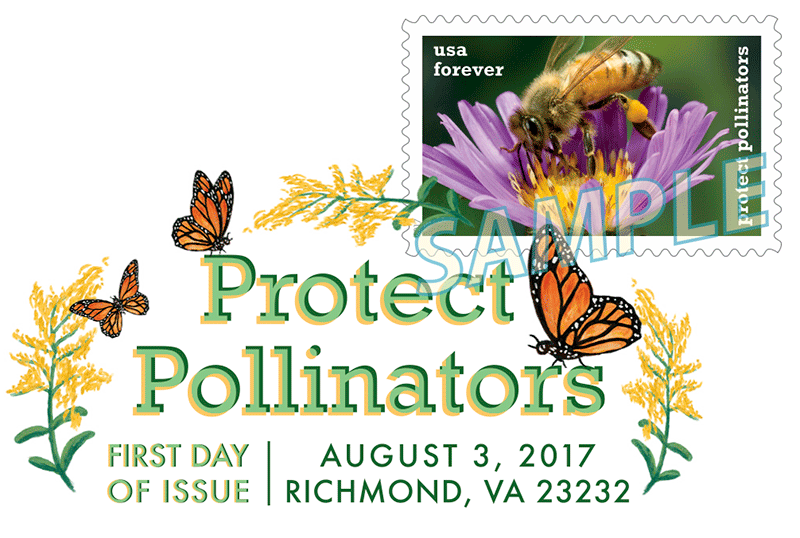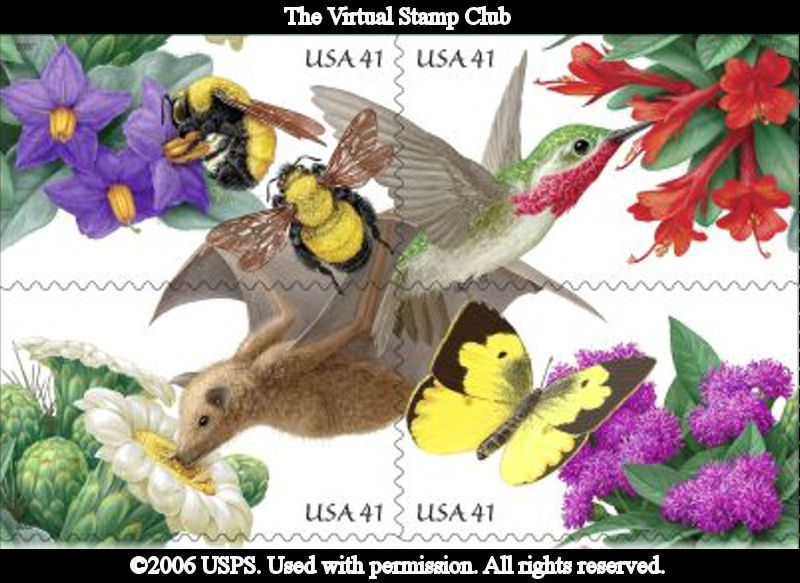Updated September 3rd: The Scott catalogue numbers for this issue are
5228 (49¢) Protect Pollinators – Monarch Butterfly on Purple Coneflower
5229 (49¢) Protect Pollinators – Western Honeybee on Golden Ragwort
5230 (49¢) Protect Pollinators – Monarch Butterfly on Red Zinnia
5231 (49¢) Protect Pollinators – Western Honeybee on Purple New England Aster
5232 (49¢) Protect Pollinators – Monarch Butterfly on Goldenrod
a. Vert. strip of 5, #5228-5232
Updated July 23rd:
The Beauty of Pollinators to be Celebratedon Forever Stamps
Media advisory
 WHAT: First-Day-of-Issue dedication ceremony for the Protect Pollinators Forever stamps. The event is free and open to the public.
WHAT: First-Day-of-Issue dedication ceremony for the Protect Pollinators Forever stamps. The event is free and open to the public.
WHO:
- U.S. Postal Service Judicial Officer Gary Shaprio
- U.S. Postal Service Stamp Services Director Mary-Anne Penner
- American Philatelic Society President Mick Zais
- The Pollinator Partnership President & CEO Val Dolcini
WHEN: Tue., Aug. 3 @ noon
WHERE:
American Philatelic Society (APS) National Summer Convention StampShow
Greater Richmond Convention Center
403 N. Third Street
Richmond, VA 23219
The event is free, open to the public, and attendees can register on-site at APS registration.
Please share the news on social media using the hashtags #ProtectPollinators and #PollinatorStamps. The stamps may be pre-ordered at this link for delivery shortly after the Aug. 3 issuance.
 BACKGROUND: The U.S. Postal Service pays tribute to the beauty and importance of pollinators with stamps depicting two of our continent’s most iconic, the monarch butterfly (Danaus plexippus) and the western honeybee (Apis mellifera), each shown industriously pollinating a variety of plants native to North America.
BACKGROUND: The U.S. Postal Service pays tribute to the beauty and importance of pollinators with stamps depicting two of our continent’s most iconic, the monarch butterfly (Danaus plexippus) and the western honeybee (Apis mellifera), each shown industriously pollinating a variety of plants native to North America.
The stamps from top left to right feature a monarch and a coneflower (photo by Karen Mayford); a monarch and a zinnia (photo by Bonnie Sue Rauch); a monarch and a goldenrod (photo by Justin Fowler); a western honeybee and a golden ragwort (photo by George D. Lepp); and in the second row, the second image from the left, a western honeybee and a New England aster (photo by Michael Durham). The remaining stamps in this pane of 20 are showcased in a scattered arrangement reminiscent of a field of wildflowers. The selvage photograph features a monarch and a goldenrod — a different view of the same two species depicted on one of the stamps (photo by Justin Fowler).
Updated March 13th:
Here is the Digital Color Postmark for this issue:  It measures 2.90″ x 1.45″.
It measures 2.90″ x 1.45″.
Updated March 13th:
 On August 3, 2017, in Richmond, VA, the U.S. Postal Service® will issue the Protect Pollinators stamps (Forever® priced at 49 cents), in five designs, in a pressure-sensitive adhesive (PSA) pane of 20 stamps (Item 475200). The Protect Pollinators $9.80 pane of 20 stamps may not be split, and the stamps may not be sold individually. The stamps will go on sale nationwide August 3, 2017.
On August 3, 2017, in Richmond, VA, the U.S. Postal Service® will issue the Protect Pollinators stamps (Forever® priced at 49 cents), in five designs, in a pressure-sensitive adhesive (PSA) pane of 20 stamps (Item 475200). The Protect Pollinators $9.80 pane of 20 stamps may not be split, and the stamps may not be sold individually. The stamps will go on sale nationwide August 3, 2017.
The U.S. Postal Service pays tribute to the beauty and importance of pollinators with stamps depicting two of our continent’s most iconic: the monarch butterfly (Danaus plexippus) and the western honeybee (Apis mellifera), each shown industriously pollinating a variety of plants native to North America.
The stamps feature:
- A monarch and a coneflower (photo by Karen Mayford);
- A western honeybee and a golden ragwort (photo by George D. Lepp);
- A monarch and a zinnia (photo by Bonnie Sue Rauch);
- A western honeybee and a New England aster (photo by Michael Durham); and
- A monarch and goldenrod (photo by Justin Fowler)
The remainder of the stamps in this pane recur in a scattered arrangement reminiscent of a field of wildflowers. The selvage photograph features a monarch and a goldenrod — a different view of the same two species depicted on one of the stamps (photo by Justin Fowler). These particular species exemplify the ecological service provided by all pollinators, which include other insects, birds, and bats. Trending declines in their populations alert us that pollinators now need mindful human intervention in order to thrive. Individuals can help butterflies, bees, and other pollinators by planting pollinator gardens that include native flowers or heirloom varieties of fruits and vegetables. Art director Derry Noyes designed this stamp pane with existing photographs.
Stamp Fulfillment Services will make an automatic push distribution to Post Offices™ of a quantity to cover approximately 30 days of sales.
How to Order the First-Day-of-Issue Postmark:
Customers have 60 days to obtain the first-day-of-issue postmark by mail. They may purchase new stamps at their local Post Office, at The Postal Store® website at usps.com/shop, or by calling 800-782-6724. They should affix the stamps to envelopes of  their choice, address the envelopes (to themselves or others), and place them in a larger envelope addressed to:
their choice, address the envelopes (to themselves or others), and place them in a larger envelope addressed to:
FDOI – Protect Pollinators Stamps
USPS Stamp Fulfillment Services
8300 NE Underground Drive, Suite 300
Kansas City, MO 64144-9900
After applying the first-day-of-issue postmark, the Postal Service™ will return the envelopes through the mail. There is no charge for the postmark up to a quantity of 50. There is a 5-cent charge for each additional postmark over 50. All orders must be postmarked by October 3, 2017.
Philatelic products for this stamp issue are as follows:
- 475206 Press Sheet with Die-cut, $88.20
- 475210 Digital Color Postmark Keepsake (set of 5), $18.95
- 475216 First-Day Cover (set of 5), $4.65
- 475221 Digital Color Postmark (set of 5), $8.20
- 475224 Framed Art, $29.95
- 475230 Ceremony Program, $6.95
- 475233 Panel, $10.95
Technical Specifications:
Issue: Protect Pollinators Stamps
Item Number: 475200
Denomination & Type of Issue: First-Class Mail® Forever
Format: Pane of 20 (5 designs)
Series: N/A
 Issue Date & City: August 3, 2017, Richmond, VA 23232
Issue Date & City: August 3, 2017, Richmond, VA 23232
Art Director: Derry Noyes, Washington, DC
Designer: Derry Noyes, Washington, DC
Typographer: Derry Noyes, Washington, DC
Existing Photos: Michael Durham, George D. Lepp, Karen Mayford, Bonnie Sue Rauch, Justin Fowler
Modeler: Joseph Sheeran
Manufacturing Process: Offset
Printer: Ashton Potter (USA) Ltd. (APU)
Printed at: Williamsville, NY
Press Type: Muller A76
Stamps per Pane: 20
Print Quantity: 60,000,000 stamps
Paper Type: Nonphosphored Type III, Block Tag applied
Adhesive Type: Pressure-sensitive
Processed at: Ashton Potter (USA) Ltd. (APU)
Colors: Black, Cyan, Magenta, Yellow
Stamp Orientation: Horizontal
Image Area (w x h): 1.42 x 0.84 in/36.07 x 21.34 mm
Overall Size (w x h): 1.56 x 0.98 in/39.62 x 24.89 mm
Full Pane Size (w x h): 7.24 x 7.83 in/183.90 x 198.88 mm
Press Sheet Size (w x h): 21.97 x 24.365 in/558.04 x 618.87 mm
Plate Size: 180 stamps per revolution
Plate Numbers: “P” followed by four (4) digits
Marginal Markings:
Front: Plate Numbers in two corners of pane • Header “Protect Pollinators”
Back: ©2016 USPS • USPS Logo • Two barcodes (475200) • Plate Position Diagram • Promotional Text
Updated March 13th: The USPS says these stamps will be issued August 3rd in Richmond VA. That would coincide with the first day of APS StampShow.
 From the USPS, November 22nd, 2016:
From the USPS, November 22nd, 2016:
This stamp pays tribute to the beauty and importance of pollinators with stamps depicting two of our continent’s most iconic, the monarch butterfly and the western honeybee, each shown industriously pollinating a variety of plants native to North America. These particular species exemplify the ecological service provided by all pollinators, which include other insects, birds, and bats. Crop pollination by insects contributes approximately $15 billion of produce to the U. S. economy each year. Trending declines in their populations alert us that pollinators are helped by planting pollinator gardens with native flowers or heirloom varieties of fruits and vegetables. Art director Derry Noyes designed this stamp pane with existing photographs.
Comment:
This subject was previous covered by the USPS in 2007: 




Image for the DCP in the 22 June Postal Bulletin. Nothing for a Pictorial Cancel, maybe just a 4-bar…
With the pain of 20, can one expect to receive 4 each of the 5 designs?